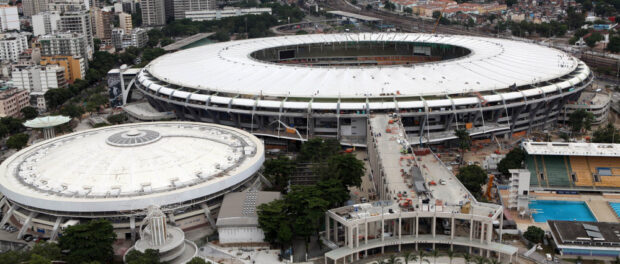
As a symbolic space in Rio de Janeiro, there is little to compare to the Maracanã stadium. Its history and position in the urban imagination is tightly linked to the cultural and social history of Rio de Janeiro in the latter half of the 20th century. Since before the wholly unexpected and traumatic defeat in the final of the 1950 World Cup against Uruguay–regarded as a “national tragedy”– the stadium has been a “temple” and a “sacred space” of football, a place where Brazil’s jogo bonito was developed and curated, a place where players became legends. As one critic has it, the “mythic Maracanã” is “a structure that will always recall its rich history, even as its dramatic transformation leads to contested debate about the future of the city and country within which it stands.” Despite not hosting the World Cup kick-off, it will host seven games–including the final–and will be the venue for the opening and closing ceremonies of the Olympics in 2016. All eyes are on this stadium. After three renovations since 2000, adding up to $550m in costs, what can we say about this stadium today?
Stadiums are, in their pure form, places for people to gather, and–at least in theory–democratic spaces for various social strata to come together in experiencing the spectacle. In Rio, the Maracanã as a democratic space took on extra importance, given the city’s infamous inequality, lack of representation, and stigmatization of favela citizens. The Maracanã has historically been experienced as a place for people to live certain “intense” experiences that can only take place in that space, in that moment. It has been, and should remain, a special place.
Noise and experience
Ever since attracting a world record attendance of over 200,000 people in the 1950 final (which Brazil lost 2-1), the stadium became deeply entrenched in the physical and cultural geography of the city. It has hosted the city’s biggest football matches, cup finals, internationals, as well as rock concerts, Catholic masses, and other large-scale events, and is the home ground for two of Rio’s most famous teams, Flamengo and Fluminense.
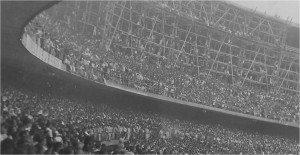 The red and black of Flamengo is considered the clube do povo, the people’s club, where the “povo” is understood as the poorer sectors of society; it is the working class, black, and favela residents’ club before anything else. They are the most widely supported team in Rio, and Brazil, and came into existence in 1911 after a group of fans broke away from Fluminense, dissatisfied with the exclusionary–what we today would call racist–nature of that club at the time. Fluminense, the tricolor, originally played in the Laranjeiras Stadium, the high-end part of the city where Oscar Cox, a Brazilian aristocrat with English heritage, founded the club in 1902. Since the 1950s, Fla and Flu have played their home games in the Maracanã, and sometimes the stadium hosts other big classics that involve the city’s other two main teams, Botafogo and Vasco da Gama. The Maracanã, as an experiential space, used to be unparalleled in Rio de Janeiro. Rich, poor, black, white, or mestiço, this was a place first and foremost for futebol. Why was it so special?
The red and black of Flamengo is considered the clube do povo, the people’s club, where the “povo” is understood as the poorer sectors of society; it is the working class, black, and favela residents’ club before anything else. They are the most widely supported team in Rio, and Brazil, and came into existence in 1911 after a group of fans broke away from Fluminense, dissatisfied with the exclusionary–what we today would call racist–nature of that club at the time. Fluminense, the tricolor, originally played in the Laranjeiras Stadium, the high-end part of the city where Oscar Cox, a Brazilian aristocrat with English heritage, founded the club in 1902. Since the 1950s, Fla and Flu have played their home games in the Maracanã, and sometimes the stadium hosts other big classics that involve the city’s other two main teams, Botafogo and Vasco da Gama. The Maracanã, as an experiential space, used to be unparalleled in Rio de Janeiro. Rich, poor, black, white, or mestiço, this was a place first and foremost for futebol. Why was it so special?
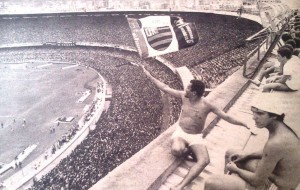 The experience of the stadium used to be second to none: the concrete bowl, packed with over 100,000 people, would create an immense, powerful atmosphere. The geral, effectively a standing area, had very cheap tickets, and there were incrementally more expensive parts of the stadium, depending on how you wanted to live the game. The wave of noise in the stadium and the intense environment of the torcida (a Brazilian term for a crowd of football fans) was an enhanced experience that bordered on the religious, devotional, or spiritual. It was in this way that it gained its iconic, and mythical, status in Rio as a “sacred temple” of football. So what is the problem with the World Cup?
The experience of the stadium used to be second to none: the concrete bowl, packed with over 100,000 people, would create an immense, powerful atmosphere. The geral, effectively a standing area, had very cheap tickets, and there were incrementally more expensive parts of the stadium, depending on how you wanted to live the game. The wave of noise in the stadium and the intense environment of the torcida (a Brazilian term for a crowd of football fans) was an enhanced experience that bordered on the religious, devotional, or spiritual. It was in this way that it gained its iconic, and mythical, status in Rio as a “sacred temple” of football. So what is the problem with the World Cup?
In accordance with FIFA regulations for such a venue, the geral was the first part of the stadium to be changed in the renovations that were completed for the World Cup. On a practical level, this greatly reduced the capacity of the Maracanã and deeply impacted the vital experiential aspect. The density and intensity of experience and atmosphere were irreversibly reduced by the contemporary renovations, which–on a cultural and symbolic level–is a travesty. Not only do you lose the numbers of people, but you also make the stadium less egalitarian and more exclusive: ticket prices go up, and divisions within and outside the stadium increase. In its new manifestation, it becomes a symbol not of progress, but instead–and paradoxically–cements societal divisions in Brazil’s late-capitalist growth. Rather than drawing on the aspects of its past that have positively defined it (inclusivity, democracy, atmosphere), there is instead a simulacra, a pastiche of its past that looks the same on the surface but that embodies the push for modernity in the contemporary city. Its now-shoddy architecture is broadly the same, with a new roof and new seats, but in its heart, the stadium is worse.
Privatization and eviction controversy
In terms of ownership, the changes to the Maracanã compound this sentiment. It used to be the people’s stadium, in more ways than just its atmosphere and democracy: it was owned by the state and, as such, in effect a public building. On June 30 last year, however, ownership passed from the state of Rio de Janeiro to a private consortium, despite numerous attempts to block the privatization via both legal means and protests. For the World Cup, Olympics, and until 2048, the consortium will administer the venue, for profit. The deal was done at a financial loss to the state, with the taxpayer having paid for all the renovations up until 2013 (the costliest part), and in return receiving around $2m per year for the duration of the deal, with the consortium taking care of the upkeep and remaining renovations.
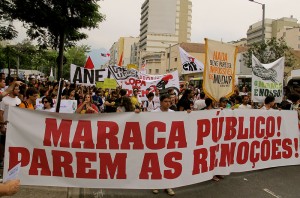 Without a doubt, the privatization of the Maracanã makes it less a stadium of and for Rio, and rather one for FIFA, the IOC and the companies, signifying the loss of an architectural icon for the city. The quest to run the stadium for private profit, with little regard for its history, has caused uproar, and whatever way you look at the figures it does not make a lot of sense–another example of short-sighted historical perspective and developmental naivety.
Without a doubt, the privatization of the Maracanã makes it less a stadium of and for Rio, and rather one for FIFA, the IOC and the companies, signifying the loss of an architectural icon for the city. The quest to run the stadium for private profit, with little regard for its history, has caused uproar, and whatever way you look at the figures it does not make a lot of sense–another example of short-sighted historical perspective and developmental naivety.
The 2014 World Cup offered up the potential for the Maracanã to be renovated, or rebuilt, as one of the world’s finest and most famous stadiums. It also could have inspired positive debate in Brazil and Rio about the fundamental rights that are denied certain sectors of society–typically indigenous or favela groups–had the renovations been sensitive to a cross-section of Brazilian social history, rather than inspiring bad blood and protests.
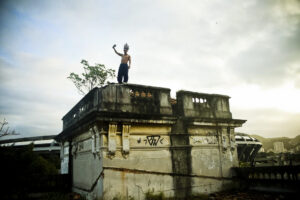 The Aldeia Maracanã is a classic example, and a point of great controversy: since 2006, there has been an indigenous group occupation near the stadium and the former Indigenous Museum (itself slated for demolition), which security forces violently evicted last year, without dialogue and to widespread consternation. As such, the World Cup, embodied by the Maracanã, has instead helped cement deep societal rifts whilst superficially papering over them for its projected image. In 1950 at least it was built partly with the idea of bringing the poor into a national project as a populist government attempted to integrate the population–this has been tragically forgotten in recent years with the World Cup, and Olympic, monstrosities. As Simon Jenkins wrote in The Guardian, this was a real chance to make these big events–run for profit by FIFA and the IOC–work for the city, and not the other way round. It is a shame that Rio and Brazil did not do it, instead playing the game just as FIFA want it to be played–not exactly a jogo bonito–with scant regard for the well-being of the country in question. Blame, of course, does not lie just with them–the Brazilian FA and politicians are concerned with projecting a certain image of an ‘advancing’ nation, one with ‘progress’ at its heart, rather than looking inside the wonderfully rich city for its identity. Familiar rhetoric, but one that has backfired. For Brazil, once again, it could have been so much better.
The Aldeia Maracanã is a classic example, and a point of great controversy: since 2006, there has been an indigenous group occupation near the stadium and the former Indigenous Museum (itself slated for demolition), which security forces violently evicted last year, without dialogue and to widespread consternation. As such, the World Cup, embodied by the Maracanã, has instead helped cement deep societal rifts whilst superficially papering over them for its projected image. In 1950 at least it was built partly with the idea of bringing the poor into a national project as a populist government attempted to integrate the population–this has been tragically forgotten in recent years with the World Cup, and Olympic, monstrosities. As Simon Jenkins wrote in The Guardian, this was a real chance to make these big events–run for profit by FIFA and the IOC–work for the city, and not the other way round. It is a shame that Rio and Brazil did not do it, instead playing the game just as FIFA want it to be played–not exactly a jogo bonito–with scant regard for the well-being of the country in question. Blame, of course, does not lie just with them–the Brazilian FA and politicians are concerned with projecting a certain image of an ‘advancing’ nation, one with ‘progress’ at its heart, rather than looking inside the wonderfully rich city for its identity. Familiar rhetoric, but one that has backfired. For Brazil, once again, it could have been so much better.
Two faces of the “Tragedy”
When the stadium opened in 1950, it had an instant impact: it was the biggest stadium in the world at the time, and amongst the biggest in history. It was also built–or, at least, ready to be played in–in under two years (it was not fully completed until 1965). It was a deep and far-reaching statement by the Brazilian government, under Eurico Dutra, a former Minister of War and President of Brazil from 1946-51. He was a political ally of Getúlio Vargas, having worked with him in the establishment of the Estado Novo, and Vargas preceded him (until his deposition in 1945) and also succeeded him in 1951–Vargas’ presence, although not official, was still there in the sense that rapid modernization and developments were still de rigeur.
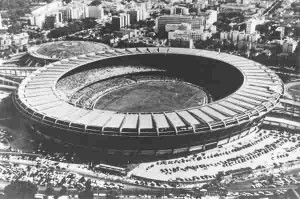 The international context was also fundamental. The stadium marked the post-World War II era with the first major soccer tournament, and the second major sporting event after the London Olympics in 1948. Whilst Europe was embroiled in the aftermath of and fallout from World War II, Brazil hosted the 1950 World Cup–and celebrated it by building an impressive stadium to host it. It was a statement that helped reinforce that, perhaps, Brazil–with Rio, the then-capital, at its center–was indeed the country of the future, as Zweig had famously proclaimed several years earlier. Moreover, Rio (and Brazil) was still in the avant-garde of the dominant Modernist aesthetic and the stadium was an expression of this architectural confidence–build quickly, build big, and make a statement.
The international context was also fundamental. The stadium marked the post-World War II era with the first major soccer tournament, and the second major sporting event after the London Olympics in 1948. Whilst Europe was embroiled in the aftermath of and fallout from World War II, Brazil hosted the 1950 World Cup–and celebrated it by building an impressive stadium to host it. It was a statement that helped reinforce that, perhaps, Brazil–with Rio, the then-capital, at its center–was indeed the country of the future, as Zweig had famously proclaimed several years earlier. Moreover, Rio (and Brazil) was still in the avant-garde of the dominant Modernist aesthetic and the stadium was an expression of this architectural confidence–build quickly, build big, and make a statement.
The first stone was laid on August 2, 1948. In under two years–and despite construction falling behind schedule and going over-budget–the stadium was ready to host games in the competition, including the final–in what remains the highest-attended football match in history. It was built on an old horserace track, close to downtown and in an area of the city that was growing under the mid-century modernizations out towards the North Zone, and as such it was symbolic of these developments and the expansion of the city. Its big concrete bowl, wrapped around the pitch, did not offer much intimacy or luxury in viewing games (the toilets were barely ready for use in 1950), and architecturally it was not particularly inspired, but it did make an impact, and was a societal space.
History repeating
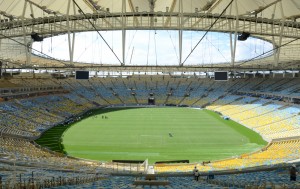 It is easy to be critical of the situation in the 2010s, but actually you see that history repeats itself: the original construction of the Maracanã in 1950 was a farce, but it was pulled together somehow, and the same happened again in the 2010s–it is little remembered that it was a last minute job back then. Workers died, there was big controversy in the use of public funds, protests, and in fact the stadium was not completed until 1965. Often ‘forgotten’ by history in place of the results on the pitch and as a result of the impact of the spectacle in historical remembrance, the construction process back then was also dogged by opposition and problems, but we remember the 1950 final and what has happened since then. The expense and location of the stadium was criticized, and intellectuals opposed the uninhibited investment in stadiums and not so much in schools and hospitals–sound familiar? The protests in June 2013 were about exactly the same things. The same happens with controversies in the 2010s about construction: the lasting remembrance and memory will unfortunately be about what happens on the pitch, not about the contemporary context. Viewing this stadium, an ongoing center of the city, in its historical context and continuum is an important recognition of its symbolic value in Rio de Janeiro.
It is easy to be critical of the situation in the 2010s, but actually you see that history repeats itself: the original construction of the Maracanã in 1950 was a farce, but it was pulled together somehow, and the same happened again in the 2010s–it is little remembered that it was a last minute job back then. Workers died, there was big controversy in the use of public funds, protests, and in fact the stadium was not completed until 1965. Often ‘forgotten’ by history in place of the results on the pitch and as a result of the impact of the spectacle in historical remembrance, the construction process back then was also dogged by opposition and problems, but we remember the 1950 final and what has happened since then. The expense and location of the stadium was criticized, and intellectuals opposed the uninhibited investment in stadiums and not so much in schools and hospitals–sound familiar? The protests in June 2013 were about exactly the same things. The same happens with controversies in the 2010s about construction: the lasting remembrance and memory will unfortunately be about what happens on the pitch, not about the contemporary context. Viewing this stadium, an ongoing center of the city, in its historical context and continuum is an important recognition of its symbolic value in Rio de Janeiro.
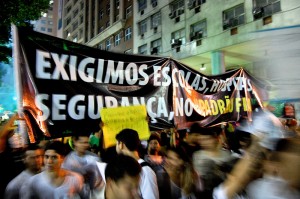 The 2010s were perhaps the opportunity to make a statement on the world stage that both worked for Brazil and its image abroad, as in 1950 by making the biggest stadium in the world. Nonetheless, there was a lack of architectural creativity or innovation with the current Maracanã redevelopments, and the renovations in the 2010s did not greatly improve the stadium, or make it into a globally leading venue. Rather, it is bereft of architectural creativity, and instead relied precisely on its nostalgic history as a “temple” of soccer, a spiritual home, for its identification in the contemporary moment, adding a roof and taking out some seats, whilst removing the foundational elements of noise, atmosphere, and experience, and damaging its democratic value. The changes made to the stadium hardly improved the structure, facilities, or architecture of the stadium, nor did they make it better or more accessible for fans. Rather the reverse, in fact, and that is a tragedy.
The 2010s were perhaps the opportunity to make a statement on the world stage that both worked for Brazil and its image abroad, as in 1950 by making the biggest stadium in the world. Nonetheless, there was a lack of architectural creativity or innovation with the current Maracanã redevelopments, and the renovations in the 2010s did not greatly improve the stadium, or make it into a globally leading venue. Rather, it is bereft of architectural creativity, and instead relied precisely on its nostalgic history as a “temple” of soccer, a spiritual home, for its identification in the contemporary moment, adding a roof and taking out some seats, whilst removing the foundational elements of noise, atmosphere, and experience, and damaging its democratic value. The changes made to the stadium hardly improved the structure, facilities, or architecture of the stadium, nor did they make it better or more accessible for fans. Rather the reverse, in fact, and that is a tragedy.
“Today Brazil has the biggest and most perfect stadium in the world, dignifying the competence of its people and its evolution in all branches of human activity,” ran the A Noite newspaper report on the eve of the World Cup 64 years ago. Perhaps then, more than ever before, the future–at least in terms of spectacle, statement, and recognition–had arrived. This was 1950, the perfect national stadium for the much-anticipated victory in the World Cup. However, the world’s biggest stadium never completely had its moment, the true raison d’être behind its construction. This was a massive new stadium that acted as a conveyer of image of power and prominence for the city–and nation–for consumption both within and outside Brazil. The Tragedy in 1950–it’s hard to understate its importance in footballing, societal, and cultural terms–was the loss against Uruguay.
Even if Brazil lifts the trophy in the Maracanã on July 13, it will not change anything that has marred the run-up to the event. The foundational myth of this old stadium was irrevocably set in stone when Brazil lost to Uruguay in 1950, and victory in 2014 would not fully overcome that. Just like, if Brazil does win, that will not make the Maracanã like it was then–a more democratic space, full of noise and spirit, a truly great football stadium. What we have now is a mere imitation, insensitive to the reality of the city around it. Sure, if they win it will be a big sporting achievement, and a remarkable victory that will lead to forgetfulness of many of the problems in the run-up to the World Cup. But this will be a short term effect. The longer-term malaise–represented by the lack of creativity and insensitivity in the renovations of the Maracanã–will merely be papered over. After the song and dance have gone, the Maracanã will remain as just one more symbol of Rio’s problematic present and those Cariocas who have to endure it. This is not to be defeatist or nostalgic–or to say that change cannot or should not happen; indeed, it is vital–but it is the nature of change and development that counts, which should be done for Rio and about Rio and in Rio’s style, and not as a shadow play of the World Cup and the Olympics.
Tom Winterbottom is completing a doctoral dissertation at Stanford University in the Iberian and Latin American Cultures department. His research focuses on the cultural study of urban centers, and he is writing his dissertation on cultural representations of contemporary Rio de Janeiro and the effect of the Olympics.
